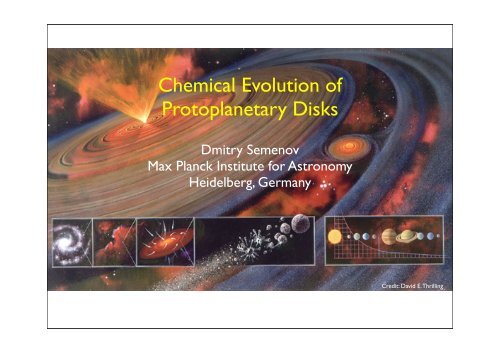Chemical Evolution of Protoplanetary Disks
Chemical Evolution of Protoplanetary Disks Chemical Evolution of Protoplanetary Disks
Chemical Evolution ofProtoplanetary DisksDmitry SemenovMax Planck Institute for AstronomyHeidelberg, GermanyCredit: David E. Thrilling
- Page 2 and 3: A scheme of disk structure• 1% o
- Page 4 and 5: Observational findings• Depletion
- Page 6 and 7: Chemistry in T Tau and Herbig Ae ou
- Page 8 and 9: Steadfast speciesLaminar Slow Mixin
- Page 10 and 11: Chemistry with grain growth• Smal
- Page 12 and 13: • Inner disk region• High-energ
- Page 14: Disks are birth sites of planetary
<strong>Chemical</strong> <strong>Evolution</strong> <strong>of</strong><strong>Protoplanetary</strong> <strong>Disks</strong>Dmitry SemenovMax Planck Institute for AstronomyHeidelberg, GermanyCredit: David E. Thrilling
A scheme <strong>of</strong> disk structure• 1% <strong>of</strong> star mass(Semenov 11)•
Astrochemistry modeling• Physical conditions• Initial abundances <strong>of</strong> molecules• Grain properties• <strong>Chemical</strong> reaction data:- Ohio State University (OSU)- Manchester University (UMIST)- KIDA (Bordeaux)- ~10 – 20% rates are accurate(Willacy & Langer 00; Aikawa ++02; Markwick ++02; van Zadelh<strong>of</strong>f ++03; Ilgner ++04;Kamp & Dullemond 04; Semenov ++05; Aikawa & Nomura 06; Tscharnuter & Gail 07;Agúndez ++08; Woods & Willacy 09; Walsh ++10; Semenov & Wiebe 11)
Observational findings• Depletion in outer disks (x5 – 100)• Photo-dominated chemistry• Cold CO, CCH, HCN• "Dry" interiors• Isotopic fractionation• Grain growth• Rich composition <strong>of</strong> inner disks(Bergin ++07; Dutrey ++07; Semenov ++10)
Panchromatic view <strong>of</strong> a protoplanetary diskIR revolution: chemistry in planet-forming zones~2,000K ~30K• NeII, FeII, OI, H 2, OH, H 2O, CO 2, HCN and C 2H 2• T 100 – 5000 K• No depletion• Herbig Ae systems show less rich molecular spectra (H2O)• Photo- and endothermic chemistry• Fischer-Tropsch/combustion chemistry?~2,000K ~30KTracing the dispersal <strong>of</strong>HerschelESAGas in Pr– Hersch(PI W. DentSample <strong>of</strong> ~200 disks (1–30 Myr)Key Tracers:[OI], [CII], H2O, CO+extensive modeling(Woitke et al. 2009,2010Kamp et al. 2010)(Lahuis ++ 06, Pascucci ++ 07-11, Salyk ++ 08-11, Pontoppidan ++ 07-11, Carr & Najita 08, Kamp++11)
Chemistry in T Tau and Herbig Ae outer disks• "Chemistry in <strong>Disks</strong>" (PdBI): >6 disks• Observations + modeling• DISCS (SMA): 12 disks• Herbig Ae: CO, HCO + , CN, HCN• T Tau: CO, HCO+ , HCN, N 2H + , CCH, CS, H2CO, DCO + , DCN• Surface densities and Tkin are OK• HAe disks are molecularly poor?• Low LX-ray in HAe: No CO + He + → C + + O + He• No low-T surface chemistry in HAe disks(Dutrey ++ 07; Schreyer ++ 08; Henning ++ 10; Öberg ++ 10-11)
Chemistry with dynamics• Turbulence & accretion• Isotopic homogeneity <strong>of</strong> the Solar Nebula• Crystalline silicates in comets and outer disk regions• Extended gas-grain chemistry• 1D/2D turbulent mixing• "ALCHEMIC" code• "Qualification" fit to observations• Reduced and oxidized ices in comets(Ilgner ++04, Willacy ++06; Nomura ++09; Hersant ++ 10;Heinzeller ++11; Semenov ++10; Semenov & Wiebe 11)
Steadfast speciesLaminar Slow Mixing Fast Mixing Column Densities• Fast gas-phase formation and destruction• Gas-phase chemistry < Dynamics• Example: CO, OH, H2O ice, CCH, C + , CN, HCN
Sensitive speciesLaminar Slow Mixing Fast Mixing Column Densities• (Partly) slow surface formation, slow desorption• Surface chemistry > Dynamics• Hydrocarbons (e.g.,C2H2), organics (HCOOH), SO, SO2,C2S, C3S
Chemistry with grain growth• Small grains stays up, big grains settle down• decreases outward• FUV reach deepr disk regions(Aikawa & Nomura 06, Fogel ++11, Vasyunin ++11)
Chemistry with grain growthUniform dust, 1μm Uniform dust, 0.1μm Evol. model Column DensitiesCO• Molecular layers shift down & expand• Depletion zone shrinks• Tracers <strong>of</strong> grain growth: e.g., C2H2/HCN, CO, CN, and SO• Tracers <strong>of</strong> Lya: e.g., HCN, NH3, and CH4• Better "qualification" agreement with observations
• Inner disk region• High-energy radiation• Dynamical processes• Grain evolutionConclusions• Basic disk chemistry is understood• "Cool" vs "warm" disks• Large observational & modeling programs• Crude chemo-dynamical models
ALMA: The Brave New WorldAtacama Large Millimeter Array (2013)• 50 x 12m + 12x7m + 4x12m• High resolution (0.005″),
<strong>Disks</strong> are birth sites <strong>of</strong> planetary systems• Initial stages <strong>of</strong> planet formation• Primordial atmospheres• Primitive bodies• Genesis <strong>of</strong> organic molecules• Molecules are probes:• Physical conditions• Kinematics• <strong>Chemical</strong> complexityCredit: Bill Saxton, NRAO/AUI/NSF



